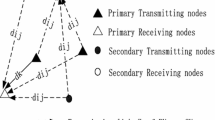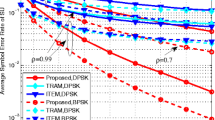Abstract
In this paper, we derive upper bound of Packet Error Probability (PEP), upper bound of delay and lower bound of throughput in cognitive radio networks. Our analysis is valid when the power of secondary source is fixed or adaptive. The secondary source can adapt its transmitting power so that interference to primary receiver is below a given threshold T. The analysis is carried in the absence and presence of interference from primary transmitter. PEP, throughput and delay are derived in closed form and validated using simulation results.










Similar content being viewed by others
Explore related subjects
Discover the latest articles, news and stories from top researchers in related subjects.References
Mitola, J., & Maguire, G. Q. (1999). Cognitive radio: making software radios more personal. IEEE Personal Communications, 6(4), 13–18.
Akyildiz, I., Lee, W. Y., Vuran, M. C., & Mohanty, S. (2006). Next generation/dynamic spectrum access/cognitive radio wireless networks: A survey. Computer Networks, 50(13), 2127–2159.
Rini, S., & Hupper, C. (2013). On the capacity of cognitive interference channel with a common cognitive message. Transaction on Emerging Telecommunication Technologies, 1, 12–18.
Alptekin, G. I., & Bener, A. B. (2011). Spectrum trading in cognitive radio networks with strict transmission power control. Transaction on Emerging Telecommunication Technologies, 22(6), 282–295.
Tan, X., Zhang, H., Chen, Q., & Hu, J. (2013). Opportunistic channel selection based on time series prediction in cognitive radio networks‘. Transaction on Emerging Telecommunication Technologies, 17(3), 32–38.
Haykin, S. (2005). Cognitive radio: Brain-empowered wireless communications. IEEE Journal on Selected Areas in Communications, 23(2), 201–220.
Menon, R., Buehrer, R., Reed, J. (November 2005). Outage probabilitybased comparison of underlay and overlay spectrum sharing techniques. In IEEE international symposium on new frontiers in dynamic spectrum access networks, Baltimore (pp. 101–109).
Chamkhia, H., Hasna, M. O., Hamila, R., Hussain, S. I. (2012). Performance analysis of relay selection schemes in underlay cognitive networks with Decode and Forward relaying. In IEEE PIMRC
Manna, M. A., Chen, G., & Chambers, J. A. (2014). Outage probability analysis of cognitive relay network with four relay selection and end-to-end performance with modified quasi-orthogonal space-time coding. IET Communications, 8(2), 233–241.
Hussain, S. I., Alouini, M.-S., Hasna, M., Qaraqe, K. (2012). Partial relay selection in underlay cognitive networks with fixed gain relays (pp. 1–5). VTC Spring
Hussain, S. I., Alouini, M. S., Qarage, K., Hasna, M. (2012) Reactive relay selection in underlay cognitive networks with fixed gain relays (pp. 1784–1788). IEE ICC
Lee, J., Wang, H., Andrews, J. G., & Hong, D. (2011). Outage probability of cognitive relay networks with interference constraints. IEEE Transactions on Wireless Communications, 10(2), 390–395.
Luo, L., Zhang, P., Zhang, G., & Qin, J. (2011). Outage performance for cognitive relay networks with underlay spectrum sharing. IEEE Communications Letters, 15(7), 710–712.
Zhong, C., Ratnarajah, T., & Wong, K.-K. (2011). Outage analysis of decode-and-forward cognitive dual-hop systems with the interference constraint in nakagami-m fading channels. IEEE Transactions on Vehicular Technology, 60(6), 2875–2879.
Kang, X., Zhang, R., Liang, Y.-C., & Garg, H. K. (2011). Optimal power allocation strategies for fading cognitive radio channels with primary user outage constraint. IEEE Journal on Selected Areas in Communications, 29(2), 374–383.
Yan, Z., Zhang, X., & Wang, W. (2011). Exact outage performance of cognitive relay networks with maximum transmit power limits. IEEE Communications Letters, 15(12), 1317–1319.
Kim, H., Lim, S., Wang, H., & Hong, D. (2012). Optimal power allocation and outage analysis for cognitive full duplex relay systems. IEEE Transactions on Wireless Communications, 11(10), 3754–3765.
Tourki, K., Qaraqe, K. A., & Alouini, M.-S. (2013). Outage analysis for underlay cognitive networks sing incremental regenerative relaying. IEEE Transactions on Vehicular Technology, 62(2), 721–734.
Guo, Y., Kang, G., Zhang, N., Zhou, W., & Zhang, P. (2010). Outage performance of relay-assisted cognitive-radio system under spectrum-sharing constraints. Electronics Letters, 46(2), 182–184. Cited by: Papers (60).
Chakraborty, P., & Prakriya, S. (2017). Secrecy outage performance of a cooperative cognitive relay network. IEEE Communications Letters, 21(2), 326–329.
He, J., Guo, S., Pan, G., Yang, Y., & Liu, D. (2017). Relay cooperation and outage analysis in cognitive radio networks with energy harvesting. IEEE Systems Journal, PP(99), 1–12.
Arezumand, H., Zamiri-Jafarian, H., & Soleimani-Nasab, E. (2017). Outage and diversity analysis of underlay cognitive mixed RF-FSO cooperative systems. IEEE/OSA Journal of Optical Communications and Networking, 9(10), 909–920.
Al-Qahtani, F. S., El-Malek, A. H. A., Ansari, I. S., Radaydeh, R. M., & Zummo, S. A. (2017). Outage analysis of mixed underlay cognitive RF MIMO and FSO relaying with interference reduction. IEEE Photonics, 9(2), 1–22.
Xi, Y., Burr, A., Wei, J. B., & Grace, D. (2011). A general upper bound to evaluate packet error rate over quasi-static fading channels. IEEE Transactions on Wireless Communications, 10(5), 1373–1377.
Babich, F. (2004). On the performance of efficient coding techniques over fading channels. IEEE Transactions on Wireless Communications, 3(1), 290–299.
Fahimi, M, Ghasemi, A. (2014) Analysis of the PRP M/G/1 queuing system for cognitive radio networks with handoff management. In 2014 22nd Iranian conference on electrical engineering (ICEE) (pp. 1047–1051).
Chu, T. M. C., Phan, H., & Zepernick, H.-J. (2013). On the performance of underlay cognitive radio networks using M/G/1/K Queueing model. IEEE Communications Letters, 17(5), 876–879.
Shi, Y., Hou, Y. T., Kompella, S., & Sherali, H. D. (2011). Maximizing capacity in multihop cognitive radio networks under the SINR model. IEEE Transactions on Mobile Computing, 10(7), 954–967.
Zhang, R. (2009). On peak versus average interference power constraints for protecting primary users in cognitive radio networks. IEEE Transactions on Wireless Communications, 8(4), 2112–20.
Chan, W. C., Lu, T. C., & Chen, R. J. (1997). Pollaczek Khinchin formula for the M/G/1 queue in discrete time with vacations. IEE Proceedings-Computers and Digital Techniques, 144(4), 222–226.
Author information
Authors and Affiliations
Corresponding author
Appendices
Appendix A
The SINR (16) can be expressed as
where \(Y_{1}=|h_{SD}|^{2},Y_{2}=|h_{S \ddot{} P_{R}}|^{2},Y_{3}=|h_{P_{T}D}|^{2},c_{1}=T,c_{2}=N_{0},c_{3}=E_{P_{T}}.\)
For Rayleigh fading channels, \(Y_{1}\),\(Y_{2}\) and \(Y_{3}\) follow an exponential distribution distributed with mean \(\mu _{i}=E(Y_{i})\).
We have
We define \(Y_{4}=c_{2}+c_{3}Y_{3}\). The CDF of \(Y_{4}\) is equal to
We deduce the PDF of \(Y_4\)
Equation (35) is expressed as
We have
For
We can write
where \(E_{i}(x)\) is the exponential integral function
Appendix B
We have
Let \(Z=E_{P_{T}}|h_{P_{T}P_{R}}|^{2}\) and \(W=N_{0}+E_{S}|h_{SP_{R}}|^{2}|\)\( |h_{SP_{R}}|^{2}<\frac{T}{E_{S}},\) we deduce
where
We finally obtain
Rights and permissions
About this article
Cite this article
Ben Halima, N., Boujemâa, H. Approximate expressions of packet error probability, throughput and delay for cognitive radio networks using fixed and adaptive transmit power. Telecommun Syst 71, 19–30 (2019). https://doi.org/10.1007/s11235-018-0515-4
Published:
Issue Date:
DOI: https://doi.org/10.1007/s11235-018-0515-4




